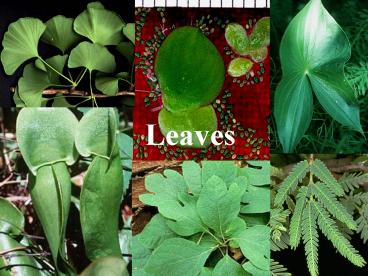Plant Physiology PowerPoint PPT Presentation
1 / 45
Title: Plant Physiology
1
Leaves
2
Leaf Structure
- Epidermal tissue system
- chloroplasts only in guard cells
- Ground tissue system
- mesophyll
- Vascular tissue system
- Leaf adaptations
- sun and shade leaves
- xerophytes
3
Photosynthesis
4
Start with the Big Picture
- Its all about energy
- potential vs kinetic energy
- Nearly all energy used on earth comes from the
sun - Nearly all energy used on earth ends up as heat
- Metabolism
- the way living things manage energy
5
Laws of Thermodynamics
- Energy can neither be created nor destroyed but
it can be converted from one form to another - In any transfer of energy there is always loss
of useful energy, usually as heat
6
What makes chemical reactions happen?
- Chemical bonds have potential energy
- When the bonds are broken, the energy is released
- Cells transfer energy from one molecule to
another, often as a proton (H) or electron (e-) - Enzymes are proteins that speed up chemical
reactions - ATP has high-energy phosphate bonds
- ATP bonds come from glucose
- Glucose comes from...
7
Metabolism summary
- Photosynthesis
- light reactions
- dark reactions
- Respiration
- glycolysis
- Krebs cycle
- electron transport
- fermentation
8
(No Transcript)
9
Photosynthesis
10
Movie
11
Light Reactions of Photosynthesis
- Chlorophyll is a pigment in the thylakoid
membrane - It can absorb light energy
- The absorbed energy knocks an electron out of the
chlorophyll molecule - This electron is transported from one molecule to
another - The energy is used to make ATP
- The original electron is replaced with one from a
molecule of water, releasing O2
Movie 1
Movie 2
12
A good summary...
13
Dark Reactions (Calvin cycle)
- Occurs in the stroma of the chloroplast
- CO2 diffuses into spongy mesophyll cells
- RUBISCO is the enzyme that fixes the CO2 into a
carbon compound - its the most abundant protein on earth
- a very complicated enzyme!
14
Rubisco
15
(No Transcript)
16
Calvin cycle
Movie
17
The atmosphere contains oxygen because of
photosynthesis
18
Oxygen causes a problem for RUBISCO
- RUBISCO binds O2 as well as CO2
- the substrates compete for the active site
- O2 results in no new sugar
- Some plants have evolved a way to avoid this
wasteful reaction
19
(No Transcript)
20
(No Transcript)
21
Some C4 plants
22
(No Transcript)
23
(No Transcript)
24
(No Transcript)
25
lt
26
lt
27
ATP
lt
28
lt
29
Water molecules
lt
Waterbox
30
Companion cells
Sieve cells
lt
31
(No Transcript)
32
lt
33
lt
34
End of Show
35
Dicot leaf surface
Monocot leaf surface
36
(No Transcript)
37
Palisade parenchyma
Upper epidermis
Xylem
Phloem
Stoma
Spongy parenchyma
Lower epidermis
38
Sun leaf and shade leaf sections
Genetic vs environmental differences in leaves
39
(No Transcript)
40
Xerophytes are plants that grow in dry conditions
41
What are the adaptations to dry conditions?
42
Leaf cross section
Which tissue holds the water?
43
Parallel venation (monocots)
Net or pinnate venation (dicots)
44
Typical horizontal leaf
Typical vertical leaf
45
(No Transcript)

